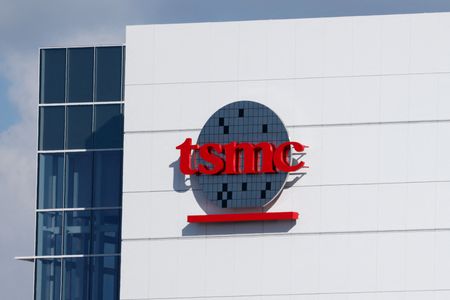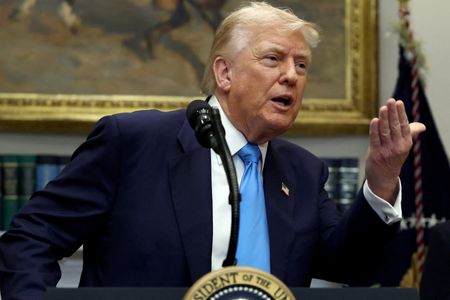By Gregor Stuart Hunter, Rae Wee and Shashwat Chauhan
(Reuters) -U.S. President Donald Trump’s Friday tariff deadline brought little reprieve for markets, with stocks around the world taking a hit as investors fretted over the cost of disrupting global supply chains and the outcome of talks with China.
For traders inured to Trump’s repeated threats, his follow-through on blanket tariffs for dozens of nations may be a wake-up call, as the deadline to strike trade deals with the United States expired and new levies arrived right on cue.
Trump’s new tariff rates include a 35% duty on many goods from Canada, 50% for Brazil, 25% for India, 20% for Taiwan and 39% for Switzerland.
The new export duties are below the “Liberation Day” tariffs unveiled on April 2, but several countries are still in talks with the United States, fueling uncertainty.
Investors are also still on edge over whether the United States and China will be able to clinch a deal to avert a tariff of 55% before their trade truce ends on August 12.
“The market – even before yesterday evening’s announcements – looked complacent on the risk of a U.S.-led global growth slowdown, which we think is to come given tariff pressures,” said Andreas Bruckner, European equity strategist at Bank of America.
It is a reminder that a U.S. president who has consistently advocated protectionist policies for decades now has the power to force higher costs on companies across complex global supply chains that took just as long to build.
The MSCI All Country World Index is up 21.2% from April lows, but has fallen for the past six consecutive sessions.
Trump hit Taiwan with a tariff of 20% on Friday, higher than the 15% the United States agreed with Japan and South Korea, though the government said it would continue to negotiate for a lower duty. Taiwan and South Korea are critical links in the supply chain of advanced logic chips and memory chips, respectively.
Stocks in Asia Pacific’s biggest tech hardware producers suffered the brunt of the selling, with South Korea’s Kospi index dropping as much as 3.8% and Taiwan’s benchmark index down as much as 1.6% before recovering.
Taiwan Semiconductor Manufacturing Company shed 1.7%, as its supplier Tokyo Electron’s shares plunged 18% after the company cut its profit forecasts by a fifth.
Tech shares across the globe felt the heat too, with Europe’s tech index dropping 2.3%. Shares of the world’s biggest supplier of computer chip-making equipment, ASML, were down 2.7%.
The tech-heavy Nasdaq index shed 2.2%, easing from record highs.
The sector shrugged off better-than-expected earnings from Apple and focused instead on a warning from CEO Tim Cook that U.S. tariffs would add $1.1 billion in costs over the period.
“We’re worried about consumer electronics companies … anywhere that’s facing large-scale consumer electronics, be it PCs or consoles or smartphones, those are the areas where we’re a bit more concerned about tariffs,” said Ben Barringer, global technology analyst at Quilter.
Weaker-than-expected results from Amazon.com’s cloud-computing unit added to the gloom.
Just in the last two weeks of July, global companies have reported a combined loss of $10.8 billion to $12 billion from tariffs. Automotive, aerospace and pharmaceutical sectors are among the worst hit.
The average tariff rate is going from about 2.5% to 15.3%, said Prashant Bhayani, chief investment officer for Asia at BNP Paribas Wealth Management.
“That’s a steep change,” he said. “But if everyone’s getting tariffed, it’s more about that relative (level), because that affects how much you get, and perhaps relative to your competitors.”
The latest tariffs also rattled currency markets, with the Swiss franc hitting a six-week low against the dollar at one point, after Trump set a 39% tariff on Swiss imports, one of the highest tariff rates in his global trade reset.
The South Korean won weakened past 1,400 per dollar for the first time since May 19 and the Taiwan dollar breached 30 against the greenback for the first time since June 4.
Most of the currencies recouped their losses after the dollar fell broadly on data showing U.S. job growth slowed much more than expected in July.
But even after the tariff deadline, some market participants said they expected agreements to remain in flux.
“It is tempting to think that a large part of the tariff uncertainty is behind us now, but we remain cautious,” said Wei Yao, head of research, Asia Pacific, at Societe Generale.
“Deals are far from finalized. The framework agreements reached so far are very vague on details, and in some cases, the U.S. has a different interpretation from the other side.”
(Reporting by Gregor Stuart Hunter, Rae Wee, Shashwat Chauhan and Purvi Agarwal; Additional reporting by Ankur Banerjee;Editing by Vidya Ranganathan, Clarence Fernandez and Devika Syamnath)












